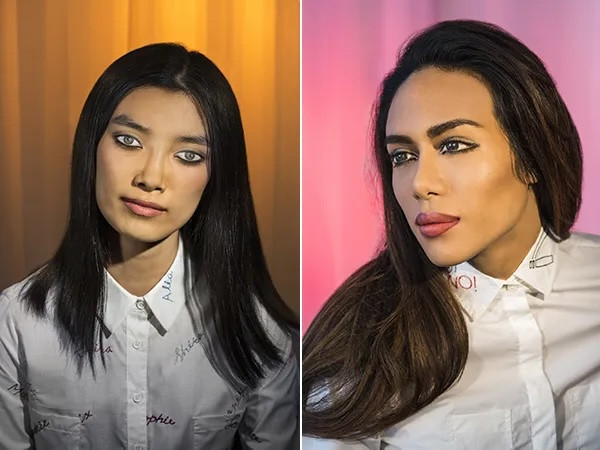Laurie Simmons is a New York–based artist. The photographs in her upcoming exhibition “Laurie Simmons: How We See” signal a shift in her work—each depicts a female figure with painted eyelids that emulate open eyes, and frames her within the banality of conventional portraiture. Accentuating the gap between the real and the presented self in the age of social media, these images will be on view at the Jewish Museum in New York from March 13 through August 9, 2015.
I’VE BEEN TRYING TO REJECT the notion of nostalgia in my work for a long time, but I feel I may’ve only gotten there recently. Reminiscence, remembrance, recollection, wistfulness, sentimentality: These don’t interest me at all any more. Longing, on the other hand, is an idea I’ve always felt a kinship with. While nostalgia alludes to a past time, longing isn’t temporally specific. It is, like regret (another favorite theme for me), the desire to know the road not taken, curiosity about a parallel life, about what might be missing, and even the future.
“How We See” is a shift for me, and it was a struggle to get here. I’ve tried so many times before to bring human figures into my pictures, mostly with some degree of failure. In my 2006 film The Music of Regret, I attempted to sum up, condense, and bid farewell to my visual language from the prior twenty-five years. I saw an opportunity to exit a place where I felt trapped, but it took several more years for me to find my way to a human subject―with a sidestep to a sculptural approximation of a girl that I found on a 2009 visit to Japan. You mentioned Barthes’s Empire of Signs, which somewhat captures my experiences there: Accepting my inability to go native, everything was new to me; everything was a jolt. I actually found comfort in feeling uncomfortable, not knowing where I was or understanding the language. I loved the dislocation. Then I found a life-size Japanese sex doll, which I could shoot in human scale. The work that followed led me to a kind of scalar disruption that was familiar to me from years of shooting miniature setups.
My new pictures, titled “How We See,” are partly concerned with the hierarchical nature of language. “How We See” could’ve been the title of one of my first or second grade reading books—it’s an announcement and maybe even a directive. When I was a kid, education was delivered to me/us in declarative sentences. There was an assumption of a kind of universality—boys and girls, dogs and cats, chocolate and vanilla, day and night, red and blue. In “How We See,” I’d like to direct you how to see while also asking you to make eye contact with ten women who can’t see you. Their closed eyelids have realistic eyes painted on them by experts (makeup artists Landy Dean and James Kaliardos). While shooting, I had to find the sweet spot where it looked like they were looking at me. I also looked toward popular, formal conventions of portraiture like school photos and engagement announcements for inspiration.
Social media allows us to put our most perfect, desirable, funny, and fake selves forward, while naturally raising questions about our longing, yearnings, and vulnerabilities. I certainly think about masking when I think about the way we present ourselves online. I’m definitely not as involved in online life as I might be were I much younger. Would I be using Tinder? Would I cyberstalk an ex-boyfriend? It’s tempting to play with the Internet, to get on board and just reinvent or invent a new reality. I had a brief flirtation with Second Life when it first came out around a dozen years ago—probably because of my attraction to constructing worlds in another scale. I loved the idea of my avatar getting friendly with other residents, but in reality it actually frightened me a little. I could imagine moving there and never really coming back. The virtual was pretty appealing in that realm; I don’t think I could’ve predicted then that there would be such a seamless synthesis of the human and digital worlds today. There is a kind of subtlety to that relationship that couldn’t have been anticipated in the early days of virtual reality.
Now, I guess people don’t have to meet and can have all of their interactions via Skype, Facebook, Twitter, and Instagram. I recently read about a Skype-inspired plastic surgery, where you could refresh your lower neck to look better on Skype. I find it intriguing that presenting yourself online could influence ideas of beauty in such a profound way and galvanize a wave of “body transformations”—it seems less technologically determinist but more about a fluid dialogue between the human and the virtual. Will it one day be a radical act to own or present the face you were born with? The possibilities for constructing a visual, physical, and theoretical identity are pretty overwhelming now.
